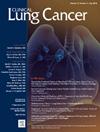在化疗无效的重症小细胞肺癌患者中开展氨柔比星加伊立替康与顺铂加伊立替康的随机 II 期试验:日本多国试验组织 (JMTO) LC 08-01 的结果。
IF 3.3
3区 医学
Q2 ONCOLOGY
引用次数: 0
摘要
研究背景我们进行了一项随机II期研究,评估拓扑异构酶II抑制剂阿鲁必钦加拓扑异构酶I抑制剂伊立替康(AI)与顺铂加伊立替康(PI)作为广泛病变(ED)小细胞肺癌(SCLC)患者一线治疗的有效性和安全性:患者: 病理证实为ED-SCLC(包括伴有恶性渗出的局限性疾病(LD)SCLC)的化疗无效患者。患者按1:1随机分配接受AI(阿鲁比星90毫克/平方米,第1天;伊立替康50毫克/平方米,第1天和第8天,21天为一个周期)或PI(顺铂60毫克/平方米,第1天;伊立替康60毫克/平方米,第1天、第8天和第15天,28天为一个周期)治疗。主要终点是1年的总生存率:共有100名患者被随机分配接受AI治疗(50人)或PI治疗(50人)。AI 的 1 年总生存率为 68.0%(95% 置信区间 (CI):56.2-82.2%),PI 为 59.2%(46.9-74.7%)(单侧 P = .18)。AI 的中位生存时间为 14.8 个月,PI 为 13.5 个月,危险比 (HR) 为 0.618(0.398-0.961,分层对数秩检验 P = .031)。AI 的中位无进展生存期为 4.8 个月,PI 为 5.4 个月(分层对数秩检验,P = .54)。AI的客观反应率为70.0%(55.4-82.1%),PI为55.1%(40.2-69.3%)(费雪精确检验,P = .15)。血液学毒性方面没有明显差异,而呕吐、食欲不振、腹泻和血清肌酐升高在 PI 中更为常见。5 名 AI 患者和 1 名 PI 患者出现间质性肺病(2 级或 3 级)。没有出现与治疗相关的死亡病例:尽管研究未达到主要终点,但AI在化疗无效的ED-SCLC患者中显示出良好的疗效和耐受性。本文章由计算机程序翻译,如有差异,请以英文原文为准。
Randomized Phase II Trial of Amrubicin Plus Irinotecan Versus Cisplatin Plus Irinotecan in Chemo-naïve Patients With Extensive-Disease Small-Cell Lung Cancer: Results of the Japan Multinational Trial Organization (JMTO) LC 08-01
Background
We conducted a randomize phase II study to evaluate the efficacy and safety of topoisomerase II inhibitor amrubicin plus topoisomerase I inhibitor irinotecan (AI) compared with cisplatin plus irinotecan (PI) as first-line therapy in patients with extensive-disease (ED) small-cell lung cancer (SCLC).
Patients and Methods
Chemo-naïve patients with pathologically proven ED-SCLC (including limited disease (LD) SCLC with malignant effusion) were enrolled. Patients were randomized 1:1 to receive either AI (amrubicin 90mg/m2 on day 1 and irinotecan 50mg/m2 on days 1 and 8 of a 21-day cycle) or PI (cisplatin 60mg/m2 on day 1 and irinotecan 60mg/m2 on days 1, 8 and 15 of a 28-day cycle). The primary endpoint was overall survival proportion at 1 year.
Results
A total of 100 patients were randomly assigned to AI (n = 50) or to PI (n = 50). The 1-year overall survival proportions were 68.0% (95% confidence interval (CI): 56.2-82.2%) for AI and 59.2% (46.9-74.7%) for PI (1-sided P = .18). Median survival time was 14.8 months for AI and 13.5 months for PI with a hazard ratio (HR) of 0.618 (0.398-0.961, stratified log-rank test P = .031). Median progression-free survival time was 4.8 months for AI and 5.4 months for PI (stratified log-rank test, P = .54). Objective response rate was 70.0% (55.4-82.1%) for AI and 55.1% (40.2-69.3%) for PI (Fisher exact test, P = .15). There was no significant difference in hematological toxicity, whereas rates of vomiting, loss of appetite, diarrhea, and elevated serum creatinine are more frequent in PI. Interstitial lung disease (Grade 2 or 3) developed in 5 patients in AI and in 1 patient in PI. There was no treatment-related death.
Conclusion
Although the study did not meet its primary endpoint, AI showed promising efficacy and good tolerability in chemo-naïve patients with ED-SCLC.
求助全文
通过发布文献求助,成功后即可免费获取论文全文。
去求助
来源期刊

Clinical lung cancer
医学-肿瘤学
CiteScore
7.00
自引率
2.80%
发文量
159
审稿时长
24 days
期刊介绍:
Clinical Lung Cancer is a peer-reviewed bimonthly journal that publishes original articles describing various aspects of clinical and translational research of lung cancer. Clinical Lung Cancer is devoted to articles on detection, diagnosis, prevention, and treatment of lung cancer. The main emphasis is on recent scientific developments in all areas related to lung cancer. Specific areas of interest include clinical research and mechanistic approaches; drug sensitivity and resistance; gene and antisense therapy; pathology, markers, and prognostic indicators; chemoprevention strategies; multimodality therapy; and integration of various approaches.
 求助内容:
求助内容: 应助结果提醒方式:
应助结果提醒方式:


